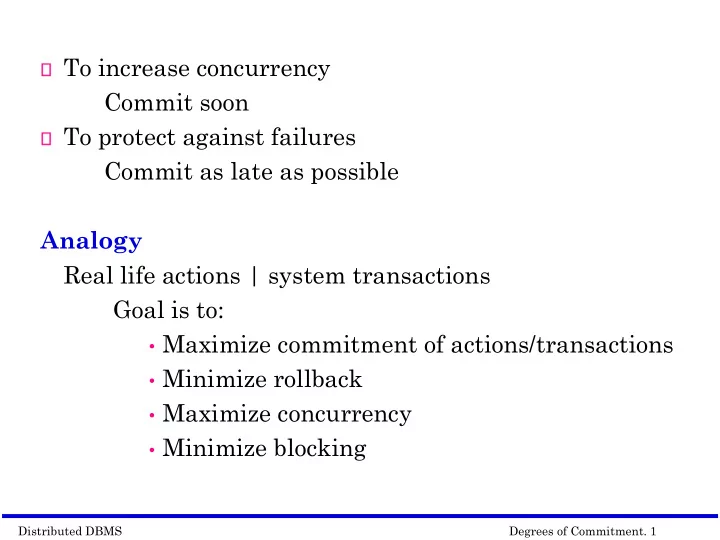

To increase concurrency Commit soon To protect against failures Commit as late as possible Analogy Real life actions | system transactions Goal is to: • Maximize commitment of actions/transactions • Minimize rollback • Maximize concurrency • Minimize blocking Distributed DBMS Degrees of Commitment. 1
Obstacles Transmission delays • Communication failure (network partition) • Site failures • Long and short transactions • Nested transactions • Possible solution: Assign a degree of {commitment, importance, success} to a • transaction Many ideas were originally mentioned by: C.T. Davies - ACM Conf., 1972 L.A. Bjor - ACM Conf., 1972 S.K. Srivastava - Symp. of Reliability in Dist. Soft/OB, 1982 Distributed DBMS Degrees of Commitment. 2
Degree of commitment (for a single transaction in the system) = 0 when transaction arrives in the system = 1 when (a) transaction has left the system permanently (b) transaction can no longer be rolled back - resources necessary to back out are lost - some undoable action has been performed (when other transactions are involved) = 1 (a) when transaction has given results to other transactions who have a degree of comm = 1 (b) dependency information among transactions has been lost Distributed DBMS Degrees of Commitment. 3
Dependency Graph GD = (V,E) V: set of nodes representing transactions (T) E: set of edges representing the dependency relation among T Types of dependency relations: (a) Concurrency control dependency T i → T j if R-W or W-W conflict T i should commit before T j (b) User defined dependencies (i) Ti → Tj if Ti should commit before Tj (ii) Ti ↔ Tj if Tj should commit simultaneously (iii) Ti ↔ Tj if either T i or T j should commit, but not both Distributed DBMS Degrees of Commitment. 4
Sphere of Dependency Ancestor: A(T) Successor: S(T) (supporter) Competitor: C(T) A(T) = {T' / T' → T in G D } * S(T) = {T'' / T → T'' in G D } * C(T) = {T''' / T ↔ T''' in G D } * Degree of commitment: D(T i ) D(T i ) > D(T j ) if W(S(T i ) > W(S(T j )) weight function Distributed DBMS Degrees of Commitment. 5
If T is aborted then S(T) is aborted Loss = W(S(T)) S cycle (T 1 ) = {T' / T' S(T 1 ) and T' A(T 1 ) } If W(S cycle (T 1 )) > W(T 1 ) then abort T 1 Distributed DBMS Degrees of Commitment. 6
Recommend
More recommend